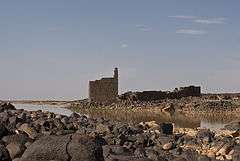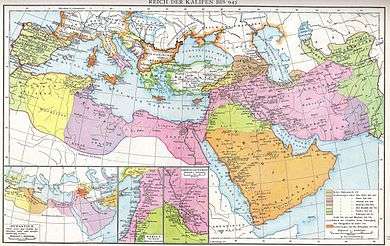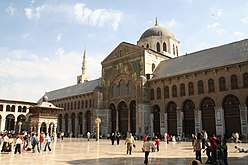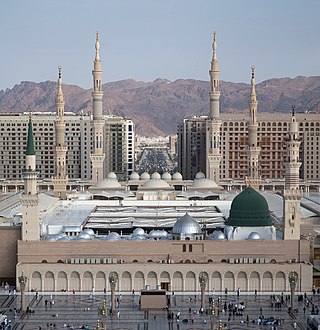Al-Walid I
Al-Walid ibn Abd al-Malik ibn Marwan (Arabic: الوليد بن عبد الملك ابن مروان, romanized: al-Walīd ibn ʿAbd al-Malik ibn Marwān; circa 674 – 23 February 715), commonly known as al-Walid I (Arabic: الوليد الأول), was the sixth Umayyad caliph, ruling from October 705 until his death. He was the eldest son of his predecessor Caliph Abd al-Malik (r. 685–705). As a prince, he led annual raids against the Byzantines in 695–698 and built or restored fortifications along the Syrian Desert route to Mecca. He became the heir apparent after the death of Abd al-Malik's brother and designated successor, Abd al-Aziz ibn Marwan, in 704.
| Al-Walid I | |||||
|---|---|---|---|---|---|
| Khalīfat Allāh Amir al-Mu'minin | |||||
 Gold dinar of al-Walid, minted in Damascus, 707/08 CE | |||||
| 6th Caliph of the Umayyad Caliphate | |||||
| Reign | 9 October 705 – 25 January or 11 March 715 | ||||
| Predecessor | Abd al-Malik | ||||
| Successor | Sulayman | ||||
| Born | 674 Medina, Umayyad Caliphate | ||||
| Died | 23 February 715 Dayr Murran, Umayyad Caliphate | ||||
| Burial | Bab al-Saghir, Damascus, Umayyad Caliphate | ||||
| Spouse |
| ||||
| Issue | Al-ʿAbbās ʿAbd al-ʿAzīz Yazīd III Ibrāhīm Bishr ʿUmar Rawḥ Muḥammad Khālid Tammām Mubashshir Jurayy ʿAbd al-Raḥmān Yaḥyā Abū ʿUbayda Masrūr Ṣadaqa Marwān | ||||
| |||||
| House | Marwanid | ||||
| Dynasty | Umayyad | ||||
| Father | ʿAbd al-Malik | ||||
| Mother | Wallāda bint al-ʿAbbās ibn al-Jazʾ al-ʿAbsīyya | ||||
| Religion | Islam | ||||
Al-Walid largely continued his father's policies of centralization and expansion, and heavily depended on al-Hajjaj ibn Yusuf, his father's powerful viceroy over the eastern half of the Caliphate. During his reign, Umayyad armies conquered the Maghreb, Hispania, Sind and Transoxiana, expanding the Caliphate to its greatest territorial extent. War spoils from the conquests allowed al-Walid to finance public works of great magnitude, including the Great Mosque of Damascus, the al-Aqsa Mosque in Jerusalem and the Prophet's Mosque in Medina. He was the first caliph to institute programs for social welfare, aiding the poor and handicapped in Syria. Although it is difficult to ascertain al-Walid's direct role in the affairs of his caliphate, his reign was marked by domestic peace and prosperity and likely represented the peak of Umayyad power.
Early life
Al-Walid was born in Medina c. 674.[1] His father, Abd al-Malik ibn Marwan, was a member of the Umayyad clan of the Quraysh tribe.[1] At the time of al-Walid's birth, another Umayyad, Mu'awiya I, was caliph.[1] The latter hailed from the Sufyanid branch of the clan, resident in Syria, while al-Walid's family belonged to the larger Abu al-As line in the Hejaz (western Arabia). Al-Walid's mother was Wallada bint al-Abbas ibn al-Jaz, a fourth-generation descendant of the 6th-century Arab chieftain Zuhayr ibn Jadhima of the Banu Abs clan of Ghatafan.[1][2] When Umayyad rule collapsed in 684 during the Second Fitna, the Umayyads of the Hejaz were expelled by a rival claimant to the caliphate, Abd Allah ibn al-Zubayr. After reaching Syria, al-Walid's grandfather, the elder statesman Marwan I, was recognized as caliph by the pro-Umayyad Arab tribes of the province, including the powerful Banu Kalb. With these tribes' support, he gradually restored the dynasty's rule in Syria and Egypt.[3] Abd al-Malik succeeded Marwan and conquered the rest of the Caliphate, namely Iraq with its eastern dependencies and Arabia.[4] With the key assistance of his viceroy in Iraq, al-Hajjaj ibn Yusuf, he instituted several centralization measures, which consolidated Umayyad territorial gains.[5]

The war with the Byzantine Empire resumed in 692 after the collapse of the ten-year truce that had been reached in 689. Annual campaigns were thereafter launched by the Umayyads in the Arab–Byzantine frontier zone and beyond. During his father's caliphate, al-Walid led the campaigns in 695, 696, 697 and 698.[6] In his summer 696 campaign, he raided the area between Malatya (Melitene) and al-Massisa (Mopsuestia), while in the following year, he targeted a place known in Arabic sources as "Atmar", located at some point north of Malatya.[7] He also led the annual Hajj pilgrim caravan to Mecca in 698.[6]
In 700/01, al-Walid patronized the construction or expansion of Qasr Burqu', a fortified Syrian Desert outpost connecting Palmyra in the north with the Azraq oasis and Wadi Sirhan basin in the south, ultimately leading to the Muslim holy cities of Mecca and Medina.[8] A dedicatory inscription at the site names al-Walid, describing him as "the emir ... son of the commander of the faithful".[9] According to the historian Jere L. Bacharach, al-Walid also built up the nearby site of Jabal Says, likely as a Bedouin summer encampment between his base of operations in al-Qaryatayn and Qasr Burqu'.[10] Bacharach speculates that al-Walid used these sites, located in the territory of Arab tribes, such as the Banu Kalb, to reaffirm their loyalty, which had been critical to the Umayyads during the civil war.[11]
Caliphate
Toward the end of his reign, Abd al-Malik, supported by al-Hajjaj, attempted to nominate al-Walid as his successor, abrogating the arrangement set by Marwan whereby Abd al-Malik's brother, the governor of Egypt, Abd al-Aziz, was slated to succeed.[12][13] Though the latter refused to step down from the line of succession, he died in 704 or early 705, removing the principal obstacle to al-Walid's nomination. After the death of Abd al-Malik on 9 October 705, al-Walid acceded.[1][12] Al-Walid's reign largely served as a continuation of his father's policies of centralization and expansion.[1][14] Unlike his father, he was heavily dependent on al-Hajjaj and allowed him free rein over the eastern half of the Caliphate.[13] Moreover, al-Hajjaj strongly influenced al-Walid's internal decision-making, with officials often being installed and dismissed upon the viceroy's direction.[13] Al-Hajjaj's prominence was such that he is discussed more frequently in the medieval Muslim sources than al-Walid or Abd al-Malik, and his time in office (694–714) is a hallmark of the continuity between the two reigns.[12]
Territorial expansion

Under al-Walid, the armies of the Caliphate "received a fresh impulse" and a "period of great conquests" began, according to historian Julius Wellhausen.[15] During the second half of his reign, the Umayyads reached their furthest territorial extent.[14] Expansion of the eastern frontier regions was overseen by al-Hajjaj from Iraq.[1] Without participating in person, he carefully chose, equipped and generously financed the commanders of the expeditions.[13]
Al-Hajjaj's lieutenant governor of Khurasan, Qutayba ibn Muslim, launched numerous campaigns against Transoxiana (Central Asia), which had been a largely impenetrable region for earlier Muslim armies, between 705 and 715.[1] Despite the distance from the Arab garrison towns of Khurasan, the unfavorable terrain and climate and his enemies' numerical superiority,[16] Qutayba, through his persistent raids, gained the surrender of Bukhara in 706–709, Khwarazm and Samarkand in 711–712 and Farghana in 713.[1] In contrast to most other Muslim conquests, he did not attempt to settle Arab Muslims in Transoxiana; instead, he secured Umayyad suzerainty through tributary alliances with local rulers, whose power remained intact.[17] The exceptions to this policy were the cities of Samarkand and Bukhara, which were each assigned Arab garrisons and tax administrators, had their Zoroastrian houses of worship razed and in the case of Samarkand, fitted with a mosque.[18] As a long-term result, both cities developed as future centers of Islamic and Arabic learning.[16] From 708/09, al-Hajjaj's nephew and lieutenant commander, Muhammad ibn Qasim, conquered Sind, the northwestern region of South Asia.[13][19]
In the west, al-Walid's governor in Ifriqiya (central North Africa), Musa ibn Nusayr, a holdover from Abd al-Malik's reign, had subjugated the Berbers of the Hawwara, Zenata and Kutama confederations and proceeded with his advance toward the Maghreb (western North Africa).[20] In 708/09, he conquered Tangier and Sus, in the far north and south of modern-day Morocco, and installed his son Marwan as governor of the former and his Berber mawlā (freedman; pl. mawālī), Tariq ibn Ziyad, as governor of Sus.[20][21] In the same year, Musa dispatched his son Abd Allah to raid the Balearic Islands.[21] Tariq invaded the Visigothic Kingdom of Hispania (Iberian Peninsula) in 711, and was reinforced by an army led by Musa in the following year.[14][20] By 716, a year after al-Walid's death, Hispania had been nearly entirely conquered.[14] The massive war spoils netted by the conquests of Transoxiana, Sind and Hispania were comparable to the amounts accrued in the early Muslim conquests during the reign of Caliph Umar ibn al-Khattab (r. 634–644).[22]
Closer to the Umayyad seat of power in Syria, al-Walid appointed his half-brother Maslama governor of the Jazira (Upper Mesopotamia) and charged him with raiding the frontier zone with Byzantium.[1] Though Maslama established a strong power base in his province, he achieved few territorial gains.[1] After a lengthy siege, the Byzantine fortress of Tyana was captured in c. 708.[23] Al-Walid entrusted most of Syria's military district governorships to his sons;[24][25] al-Abbas was assigned to Homs and fought reputably in the campaigns against Byzantium alongside Maslama, while Abd al-Aziz, who also took part in the anti-Byzantine war effort, and Umar were appointed to Damascus and Jordan, respectively.[24] Al-Walid did not participate in the campaigns and is reported to have left Syria once as caliph when he led the Hajj pilgrimage to Mecca in 710.[1]
Domestic politics
In stages between 693 and 700, Abd al-Malik and al-Hajjaj initiated the dual processes of issuing a single Islamic currency in place of the previously used Byzantine and Sasanian coinage and replacing Greek and Persian with Arabic as the language of the bureaucracy in Syria and Iraq, respectively.[26][27] These administrative reforms continued under al-Walid, during whose reign, in 705/06, Arabic replaced Greek and Coptic in the dīwān (government registers) of Egypt.[27][28] The change was implemented by the caliph's half-brother, Abd Allah, the governor of Egypt and appointee of Abd al-Malik.[29] These policies effected the gradual transition of Arabic as the sole official language of the state, unified the varied tax systems of the Caliphate's provinces and contributed to the establishment of a more ideologically Islamic government.[26][30]
As a result of the Battle of Marj Rahit, which inaugurated Marwan's reign in 684, a sharp division developed among the Syrian Arab tribes, who formed the core of the Umayyad army. The loyalist tribes that supported Marwan formed the "Yaman" confederation, alluding to ancestral roots in Yemen (South Arabia), while the Qaysi or Northern Arab tribes largely supported Ibn al-Zubayr. Abd al-Malik reconciled with the Qays in 691, though competition for influence between the two factions intensified as the Syrian army was increasingly empowered and deployed to the provinces, where they replaced or supplemented Iraqi and other garrisons.[14][31] Al-Walid maintained his father's policy of balancing the power of the two factions in the military and administration.[14] According to historian Hugh N. Kennedy, it is "possible that the caliph kept it [the rivalry] on the boil so that one faction should not acquire a monopoly of power".[14] His mother was genealogically affiliated with the Qays and he apparently accorded Qaysi officials certain advantages.[14] However, Wellhausen doubts that al-Walid preferred one faction over the other, "for he had no need to do so, and it is not reported" by the medieval historians.[32]
In response to the maltreatment of Medina's pious residents by Abd al-Malik's appointed governor to the Hejaz, Hisham ibn Isma'il al-Makhzumi, al-Walid replaced Hisham with his cousin Umar ibn Abd al-Aziz in 706; the latter had friendly ties to the region's religious circles.[15] However, Umar gained al-Hajjaj's enmity for providing safe haven to Iraqis evading his persecution.[14] Upon the advice of al-Hajjaj, al-Walid dismissed Umar in 712 and split the governorship of the Hejaz, appointing al-Hajjaj's allies Khalid ibn Abdallah al-Qasri to Mecca and Uthman ibn Hayyan al-Murri to Medina.[33] In Palestine, al-Walid's brother Sulayman cultivated strong ties to the Yaman and in 708, sheltered the deposed Yamani governor of Khurasan, Yazid ibn al-Muhallab, a fugitive from al-Hajjaj's prison.[14][34] Despite his initial disapproval, al-Walid pardoned Yazid as a result of Sulayman's lobbying and payment of the heavy fine that al-Hajjaj had imposed on Yazid.[35]
In 709, al-Walid recalled Abd Allah from Egypt, either as a result of mounting complaints against the governor, whose corruption was blamed for famine in the province, the first recorded in Islamic history, or a desire to install one of his own loyalists, his kātib (scribe), Qurra ibn Sharik al-Absi.[36][37] The latter served until his death in 715 and established a more efficient means of tax collection, enlisted more troops into Egypt's army and, on al-Walid's orders, restored the mosque of Fustat.[36]
Public works and social welfare
From the beginning of his rule, al-Walid inaugurated public works and social welfare programs on a scale unprecedented in the history of the Caliphate.[22] The efforts were financed by treasure accrued from the conquests and tax revenue.[22] Throughout his reign, the caliph and his brothers and sons built way-stations and dug wells along the roads in Syria and installed street lighting in the cities.[22] They invested in land reclamation projects, entailing irrigation networks and canals, which drove agricultural production.[22][38] Welfare programs included financial relief for the poor and servants to assist the handicapped, though this initiative was limited to Syria.[22][39]
Patronage of great mosques
The great mosque founded by al-Walid in Damascus, later known as the Umayyad Mosque, became one of his greatest architectural achievements. Under his predecessors, Muslim residents had worshipped in a small muṣallā (Muslim prayer room) attached to the 4th-century cathedral of John the Baptist, itself a successor to the temples of Hadad and then Jupiter.[40][41] However, by the time of al-Walid's reign, the muṣallā could not cope with the fast-growing Muslim community and no sufficient free spaces were available elsewhere in the urban space of Damascus for a large congregational mosque.[40] Thus, in 705, al-Walid had the church converted into a mosque, compensating local Christians with other properties in the city.[40][41] Most of the structure was demolished, with the exceptions of the exterior walls and corner towers, which were thenceforth covered by marble inlays and mosaics.[42][41] The caliph's architects replaced the demolished space with a large prayer hall and a courtyard bordered on all sides by a closed portico with double arcades.[42] A large cupola was installed at the center of the prayer hall and a high minaret was erected on the mosque's northern wall.[42] The mosque was completed in 711 and Blankinship notes that the field army of Damascus, numbering some 45,000 soldiers, were taxed a quarter of their salaries for nine years to pay for its construction.[22][42] The scale and grandeur of the great mosque made it a "symbol of the political supremacy and moral prestige of Islam", according to historian Nikita Elisséeff.[42] Noting al-Walid's awareness of architecture's propaganda value, historian Robert Hillenbrand calls the Damascus mosque a "victory monument" intended as a "visible statement of Muslim supremacy and permanence".[43] The mosque has maintained its original form until the present day.[1]
In Jerusalem, al-Walid continued his father's works on the Haram al-Sharif (Temple Mount).[25] A number of medieval-era Muslim accounts credit the construction of the al-Aqsa Mosque to al-Walid, while others credit his father.[25] Furthermore, it is likely that the currently unfinished administrative and residential structures that were built opposite the southern and eastern walls of the Haram, next to the mosque, date to the era of al-Walid, who died before they could be completed and were not finished by his successors.[44]
In 706/707, al-Walid instructed Umar ibn Abd al-Aziz to significantly enlarge the Prophet's Mosque in Medina.[45][46] Its redevelopment entailed the demolition of the living quarters of Muhammad's wives and the expansion of the structure to incorporate the graves of Muhammad and the first two caliphs, Abu Bakr (r. 632–634) and Umar ibn al-Khattab.[1][47][48] The vocal opposition to the demolition of Muhammad's home from local religious circles was dismissed by the caliph.[45] An ornate enclosure was built around the graves and fitted with a concave miḥrāb (prayer niche), four minarets and a pentagonal-shaped entrance.[48] Al-Walid lavished large sums for the mosque's reconstruction and supplied Umar with mosaics and Greek and Coptic craftsmen.[47] According to Hillenbrand, the building of a large scale mosque in Medina, the original center of the Caliphate, was an "acknowledgement" by al-Walid of "his own roots and those of Islam itself" and possibly an attempt to appease Medinese resentment at the loss of their city's political importance to Syria under the Umayyads.[45] Other mosques that al-Walid is credited for expanding in the Hejaz include the Sanctuary Mosque around the Ka'aba in Mecca and the mosque of Ta'if.[22]
Death and legacy
Al-Walid died of an illness in Dayr Murran, an Umayyad winter estate on the outskirts of Damascus,[49] on 23 February 715,[1][50] about one year after al-Hajjaj's death.[19][note 1] He was buried in Damascus at the cemetery of Bab al-Saghir or Bab al-Faradis and Umar ibn Abd al-Aziz led the funeral prayers.[52][51] He had attempted to nominate his son Abd al-Aziz as his successor, voiding the arrangements set by his father, in which Sulayman was to accede after al-Walid.[1] Relations between the two brothers had apparently become strained.[1] However, al-Walid was unable to secure this change before his death and Sulayman succeeded without opposition.[1] The latter dismissed nearly all of al-Walid's governors, and though he maintained the militarist policies of al-Walid and Abd al-Malik, expansion of the caliphate largely ground to a halt under Sulayman (r. 715–717).[53] Two of al-Walid's sons, Yazid III and Ibrahim, successively served as caliphs for less than a year in 744.[54]
By virtue of the conquests of Hispania, Sind and Transoxiana during his reign, his patronage of the great mosques of Damascus and Medina and his charitable works, al-Walid's Syrian contemporaries viewed him as "the worthiest of their caliphs", according to the report of Umar ibn Shabba (died 878).[52] Numerous panegyrics were dedicated to al-Walid and his sons by al-Farazdaq, his official court poet.[55] The latter's contemporary, Jarir, lamented the caliph's death, proclaiming: "O eye, weep copious tears aroused by remembrance; after today there is no point in your tears being stored."[56] According to Hawting, the reigns of al-Walid and Abd al-Malik, tied together by al-Hajjaj, represented in "some ways the high point of Umayyad power, witnessing significant territorial advances both in the east and the west and the emergence of a more marked Arabic and Islamic character in the state's public face".[12] Domestically it was generally a period of peace and prosperity.[1][14] Kennedy asserts that al-Walid's reign was "remarkably successful and represents, perhaps, the zenith of Umayyad power", though his direct role in these successes is unclear and his primary accomplishment may have been maintaining the equilibrium between the rival factions of the Umayyad family and military.[1]
The 9th-century historian al-Ya'qubi describes al-Walid's physical appearance as "tall and swarthy", "snub-nosed ... with a touch of gray [sic] at the tip of his beard" and that he "spoke ungrammatically".[57] To his father's chagrin, al-Walid abandoned speaking the classical Arabic in which the Qur'an was written, yet he insisted that everyone in his company have knowledge of the Qur'an.[58] He was also known to have embraced the formal trappings of monarchy, in a manner unprecedented among earlier caliphs.[15]
Family
Al-Walid was survived by several sons: al-Ya'qubi names sixteen,[59] while historian al-Tabari (d. 923) names nineteen.[52] Those named by both historians were Abd al-Aziz and Muhammad, both mothered by Umm al-Banin, a daughter of al-Walid's uncle Abd al-Aziz ibn Marwan; Abu Ubayda, whose mother was from the Banu Fazara tribe;[52] Abd al-Rahman, whose mother was Umm Abd Allah bint Abd Allah ibn Amr, a great-granddaughter of Caliph Uthman ibn Affan (r. 644–656), a member of the Umayyad clan;[60] Yazid III, whose mother, Shah-i Afrid or Shahfirand, was a daughter of the last Sasanian king, Peroz III, and a concubine of al-Walid given to him by al-Hajjaj;[61][62] Ibrahim, whose mother was a concubine named Su'ar or Budayra;[63] his eldest son al-Abbas, Bishr, Masrur, Umar, Rawh, Khalid, Tammam, Mubashshir, Yahya and Sadaqa, none of whose mothers are mentioned.[52][59] Al-Ya'qubi alone names Jurayy,[59] and al-Tabari alone names Mansur, Anbasa and Marwan.[52]
Notes
- Accounts recorded by the historian al-Ya'qubi (died 897/98) place al-Walid's death on 25 January or 11 March.[51]
References
- Kennedy 2002, p. 127.
- Hinds 1990, p. 118.
- Kennedy 2016, pp. 79–80.
- Kennedy 2016, p. 84.
- Kennedy 2016, p. 87.
- Marsham 2009, p. 125.
- Rowson 1989, p. 176.
- Bacharach 1996, p. 31.
- Marsham 2009, pp. 126–127.
- Bacharach 1996, pp. 31–32.
- Bacharach 1996, p. 32.
- Hawting 2000, p. 58.
- Dietrich 1971, p. 41.
- Kennedy 2016, p. 90.
- Wellhausen 1927, p. 224.
- Wellhausen 1927, p. 438.
- Kennedy 2016, pp. 90–91.
- Wellhausen 1927, pp. 437–438.
- Kennedy 2016, p. 91.
- Lévi-Provençal 1993, p. 643.
- Kaegi 2010, p. 15.
- Blankinship 1994, p. 82.
- The primary sources give different dates for the city's fall, ranging from 707 to 710. The event is generally placed in 708 or 709 by modern scholars. Lilie 1976, pp. 116–118 (esp. note 40)
- Crone 1980, p. 126.
- Bacharach 1996, p. 30.
- Gibb 1960, p. 77.
- Duri 1965, p. 324.
- Blankinship 1994, p. 38.
- Kennedy 1998, pp. 71–72.
- Blankinship 1994, pp. 94–95.
- Kennedy 2001, p. 34.
- Wellhausen 1927, pp. 225–226.
- Hinds 1990, pp. 201–202.
- Hinds 1990, pp. 160–161.
- Hinds 1990, pp. 160–162.
- Kennedy 1998, p. 72.
- Crone 1980, p. 125.
- Kennedy 2016, p. 86.
- Wellhausen 1927, p. 299.
- Elisséeff 1965, p. 800.
- Hillenbrand 1994, p. 69.
- Elisséeff 1965, p. 801.
- Hillenbrand 1994, pp. 71–72.
- Bacharach 1996, pp. 30, 33.
- Hillenbrand 1994, p. 73.
- Munt 2014, p. 106.
- Bacharach 1996, p. 35.
- Munt 2014, pp. 106–108.
- Hinds 1990, pp. 219, 222.
- Powers 1989, p. 3.
- Biesterfeldt & Günther 2018, p. 1001.
- Hinds 1990, p. 219.
- Eisener 1997, p. 821.
- Kennedy 2016, pp. 112–113.
- Blachère 1965, p. 788.
- Hinds 1990, p. 221.
- Biesterfeldt & Günther 2018, pp. 1001, 1004.
- Wellhausen 1927, pp. 224–225.
- Biesterfeldt & Günther 2018, pp. 1001–1002.
- Ahmed 2010, p. 123.
- Hillenbrand 1989, p. 234.
- Biesterfeldt & Günther 2018, p. 1056.
- Biesterfeldt & Günther 2018, p. 1058.
Bibliography
- Ahmed, Asad Q. (2010). The Religious Elite of the Early Islamic Ḥijāz: Five Prosopographical Case Studies. University of Oxford Linacre College Unit for Prosopographical Research.CS1 maint: ref=harv (link)
- Bacharach, Jere L. (1996). "Marwanid Umayyad Building Activities: Speculations on Patronage". In Necpoğlu, Gülru (ed.). Muqarnas: An Annual on the Visual Culture of the Islamic World, Volume 13. Leiden: Brill. ISBN 90-04-10633-2.CS1 maint: ref=harv (link)
- Biesterfeldt, Hinrich; Günther, Sebastian (2018). The Works of Ibn Wāḍiḥ al-Yaʿqūbī (Volume 3): An English Translation. Leiden: Brill. ISBN 978-90-04-35621-4.CS1 maint: ref=harv (link)
- Blachère, R. (1965). "Al-Farazdak". In Lewis, B.; Pellat, Ch. & Schacht, J. (eds.). The Encyclopaedia of Islam, New Edition, Volume II: C–G. Leiden: E. J. Brill. pp. 788–789. OCLC 495469475.
- Blankinship, Khalid Yahya (1994). The End of the Jihâd State: The Reign of Hishām ibn ʻAbd al-Malik and the Collapse of the Umayyads. Albany, New York: State University of New York Press. ISBN 978-0-7914-1827-7.
- Crone, Patricia (1980). Slaves on Horses: The Evolution of the Islamic Polity. Cambridge: Cambridge University Press. ISBN 0-521-52940-9.
- Dietrich, Albert (1971). "Al-Ḥadjdjādj b. Yūsuf". In Lewis, B.; Ménage, V. L.; Pellat, Ch. & Schacht, J. (eds.). The Encyclopaedia of Islam, New Edition, Volume III: H–Iram. Leiden: E. J. Brill. pp. 39–43. OCLC 495469525.
- Duri, Abd al-Aziz (1965). "Dīwān". In Lewis, B.; Pellat, Ch. & Schacht, J. (eds.). The Encyclopaedia of Islam, New Edition, Volume II: C–G. Leiden: E. J. Brill. pp. 323–327. OCLC 495469475.
- Eisener, R. (1997). "Sulaymān b. ʿAbd al-Malik". In Bosworth, C. E.; van Donzel, E.; Heinrichs, W. P. & Lecomte, G. (eds.). The Encyclopaedia of Islam, New Edition, Volume IX: San–Sze. Leiden: E. J. Brill. pp. 821–822. ISBN 90-04-10422-4.
- Elisséeff, Nikita (1965). "Dimashk". In Lewis, B.; Pellat, Ch. & Schacht, J. (eds.). The Encyclopaedia of Islam, New Edition, Volume II: C–G. Leiden: E. J. Brill. pp. 277–291. OCLC 495469475.
- Gibb, H. A. R. (1960). "ʿAbd al-Malik b. Marwān". In Gibb, H. A. R.; Kramers, J. H.; Lévi-Provençal, E.; Schacht, J.; Lewis, B. & Pellat, Ch. (eds.). The Encyclopaedia of Islam, New Edition, Volume I: A–B. Leiden: E. J. Brill. pp. 76–77. OCLC 495469456.
- Hawting, Gerald R. (2000). The First Dynasty of Islam: The Umayyad Caliphate AD 661–750 (Second ed.). London and New York: Routledge. ISBN 0-415-24072-7.
- Hillenbrand, Carole, ed. (1989). The History of al-Ṭabarī, Volume XXVI: The Waning of the Umayyad Caliphate: Prelude to Revolution, A.D. 738–744/A.H. 121–126. SUNY Series in Near Eastern Studies. Albany, New York: State University of New York Press. ISBN 978-0-88706-810-2.
- Hillenbrand, Robert (1994). Islamic Architecture: Form, Function and Meaning. New York: Columbia University Press. ISBN 0-231-10132-5.CS1 maint: ref=harv (link)
- Hinds, Martin, ed. (1990). The History of al-Ṭabarī, Volume XXIII: The Zenith of the Marwānid House: The Last Years of ʿAbd al-Malik and the Caliphate of al-Walīd, A.D. 700–715/A.H. 81–95. SUNY Series in Near Eastern Studies. Albany, New York: State University of New York Press. ISBN 978-0-88706-721-1.
- Kaegi, Walter E. (2010). Muslim Expansion and Byzantine Collapse in North Africa. Cambridge: Cambridge University Press. ISBN 978-0-521-19677-2.CS1 maint: ref=harv (link)
- Kennedy, Hugh (1998). "Egypt as a Province in the Islamic Caliphate, 641–868". In Petry, Carl F. (ed.). Cambridge History of Egypt, Volume One: Islamic Egypt, 640–1517. Cambridge: Cambridge University Press. pp. 62–85. ISBN 0-521-47137-0.CS1 maint: ref=harv (link)
- Kennedy, Hugh (2001). The Armies of the Caliphs: Military and Society in the Early Islamic State. Routledge. ISBN 0-415-25092-7.CS1 maint: ref=harv (link)
- Kennedy, Hugh N. (2002). "Al-Walīd (I)". In Bearman, P. J.; Bianquis, Th.; Bosworth, C. E.; van Donzel, E. & Heinrichs, W. P. (eds.). The Encyclopaedia of Islam, New Edition, Volume XI: W–Z. Leiden: E. J. Brill. pp. 127–128. ISBN 90-04-12756-9.
- Kennedy, Hugh (2016). The Prophet and the Age of the Caliphates: The Islamic Near East from the 6th to the 11th Century (Third ed.). Oxford and New York: Routledge. ISBN 978-1-138-78761-2.
- Lévi-Provençal, E. (1993). "Mūsā b. Nuṣayr". In Bosworth, C. E.; van Donzel, E.; Heinrichs, W. P. & Pellat, Ch. (eds.). The Encyclopaedia of Islam, New Edition, Volume VII: Mif–Naz. Leiden: E. J. Brill. pp. 643–644. ISBN 90-04-09419-9.
- Lilie, Ralph-Johannes (1976). Die byzantinische Reaktion auf die Ausbreitung der Araber. Studien zur Strukturwandlung des byzantinischen Staates im 7. und 8. Jhd (in German). Munich: Institut für Byzantinistik und Neugriechische Philologie der Universität München. OCLC 797598069.CS1 maint: ref=harv (link)
- Marsham, Andrew (2009). The Rituals of Islamic Monarchy: Accession and Succession in the First Muslim Empire. Edinburgh: Edinburgh University Press. ISBN 978-0-7486-2512-3.CS1 maint: ref=harv (link)
- Munt, Harry (2014). The Holy City of Medina: Sacred Space in Early Islamic Arabia. New York: Cambridge University Press. ISBN 978-1-107-04213-1.CS1 maint: ref=harv (link)
- Powers, Stephan, ed. (1989). The History of al-Ṭabarī, Volume XXIV: The Empire in Transition: The Caliphates of Sulaymān, ʿUmar, and Yazīd, A.D. 715–724/A.H. 96–105. SUNY Series in Near Eastern Studies. Albany, New York: State University of New York Press. ISBN 978-0-7914-0072-2.
- Rowson, Everett K., ed. (1989). The History of al-Ṭabarī, Volume XXII: The Marwānid Restoration: The Caliphate of ʿAbd al-Malik, A.D. 693–701/A.H. 74–81. SUNY Series in Near Eastern Studies. Albany, New York: State University of New York Press. ISBN 978-0-88706-975-8.
- Wellhausen, Julius (1927). The Arab Kingdom and its Fall. Translated by Margaret Graham Weir. Calcutta: University of Calcutta. OCLC 752790641.
Al-Walid I Umayyad Dynasty Born: 674 Died: 23 February 715 | ||
| Preceded by Abd al-Malik |
Caliph of Islam Umayyad Caliph 705 – 23 February 715 |
Succeeded by Sulayman |

.jpg)

